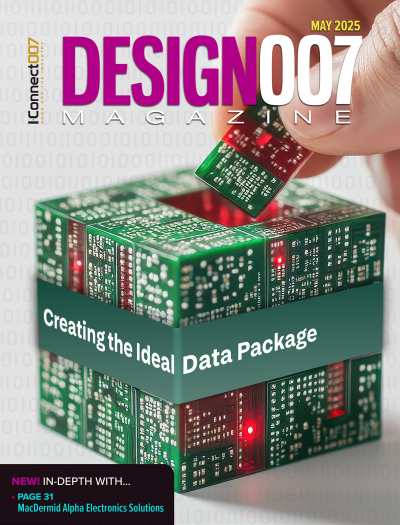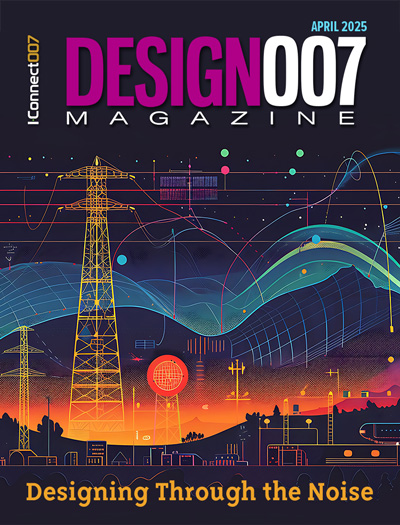-

- News
- Books
Featured Books
- design007 Magazine
Latest Issues
Current Issue
All About That Route
Most designers favor manual routing, but today's interactive autorouters may be changing designers' minds by allowing users more direct control. In this issue, our expert contributors discuss a variety of manual and autorouting strategies.

Creating the Ideal Data Package
Why is it so difficult to create the ideal data package? Many of these simple errors can be alleviated by paying attention to detail—and knowing what issues to look out for. So, this month, our experts weigh in on the best practices for creating the ideal design data package for your design.

Designing Through the Noise
Our experts discuss the constantly evolving world of RF design, including the many tradeoffs, material considerations, and design tips and techniques that designers and design engineers need to know to succeed in this high-frequency realm.
- Articles
- Columns
Search Console
- Links
- Media kit
||| MENU - design007 Magazine
Linda Mazzitelli: PTC Goes all in on ECAD/MCAD Collaboration
February 28, 2019 | Andy Shaughnessy, Design007 MagazineEstimated reading time: 4 minutes
At AltiumLive Munich, I ran into Linda Mazzitelli of PTC. Linda has worn a lot of hats in the PCB design world—she’s even married to a designer. I asked Linda to discuss her current work at PTC and the apparent convergence of ECAD and MCAD, which many think has been a long time coming for this industry.
Andy Shaughnessy: Can you start by telling us about what you’re doing with PTC and the collaboration with XPLM?
Linda Mazzitelli: Sure. I’m the product manager at PTC for the PLM segment focused on ECAD integration and partner relationships. It’s my job to make sure that our ECAD tools have a good strategy going forward, whether that’s internal or dealing with partners to help supplement our existing product line.
Shaughnessy: PLM refers to product life cycle management tools, right?
Mazzitelli: Right, so we’re actually partnering with Altium directly on an integration to our PLM product, which is Windchill, and we’re partnering with XPLM for any of the integrations that Altium does not want to do directly. For example, the integration from Altium’s Nexus to Windchill will be done by Altium, and any direct connection without Nexus will be done by XPLM.
Shaughnessy: I heard that PTC recently got some serious financial backing. You all must be on the right track.
Mazzitelli: Rockwell and PTC entered into a strategic alliance that leverages both companies resources, technologies, industry expertise and market presence. As part of the strategic alliance, Rockwell made a $1 billion equity investment in PTC.
Shaughnessy: They’re serious about it! A billion dollars is good to have on hand. PTC has always had really interesting tools, like Windchill and Creo.
Mazzitelli: And Navigate. We have a lot of tools now that also focus on AR, augmented reality, and where that comes into play is that it enables a new way for engineers to collaborate across the value chain on any device.
Shaughnessy: AR is really blowing up now. Now, in your previous life, you were a PCB designer, and you still know something about design.
Mazzitelli: Yes.
Shaughnessy: You were saying that you worked with some of the tools decades ago that have since been bought up by some of the big companies. How did you start as a designer?
Mazzitelli: As we all did, out of college I didn’t know what I wanted to do, and there was a company that was hiring. I went through a recruiter, and I was heavy in math skills when I was in college, so he suggested I apply for a design job. I had no idea what PCB design was. I sat down, they asked me a few questions, put a test in front of me and said, “Take this test.” I handed in the test, walked out, and said, “I’m never going to get this job.” By the time I got home, my phone was ringing, and they had an offer for me from a company called Algorex, which was the precursor to Applicon. I worked for them for about four years, and then I started designing with Racal-Redac, Cadnetix, CADAM Prance and several other tools. From there, I went to work for Daisy Systems as an application engineer, doing demos and showing people how to use the tools in their own environment..
Shaughnessy: A lot of designers look back and say, “Those were the golden years.”
Mazzitelli: They were. Then, Daisy bought Cadnetix and eventually went out of business, so I went over to Cadence Design Systems where I was a field AE for them. I eventually became a product manager over there and then left and worked for VeriBest for a time. So, I’ve been at several EDA vendors and ended up at PTC about six and a half years ago.
Shaughnessy: And your husband works for Freedom CAD Services Inc.
Mazzitelli: Yes, and he’s the Altium project manager as well as a designer for all the Altium work that comes into Freedom CAD.
Shaughnessy: Great. Did you come to this show last year?
Mazzitelli: I didn’t, but I came the year before when it was in San Diego where I spoke about ECAD data management at that point.
Shaughnessy: What are you speaking about here?
Mazzitelli: This year, I will be speaking about ECAD/MCAD collaboration and how it relates to Altium 365, which we were speaking about earlier.
Shaughnessy: Right. It does seem kind of strange that with ECAD and MCAD, it’s almost like “never the twain shall meet.” It’s like there are two separate silos even though you’re all working more or less together.
Mazzitelli: Exactly. Even the terminology is different. Everybody says that it’s the tools that make them different, but it’s not really. Because as a board designer, we have terminologies that we don’t even think about when we speak to each other, but when I went to PTC and had to communicate with mechanical engineers, they use the same words, but they meant completely different things. So, it’s not just collaborating on the data; it’s collaborating on the intent. And with the same words meaning two different things, it makes it even more difficult.
Shaughnessy: It’s an interesting time in the industry.
Mazzitelli: It definitely is.
Shaughnessy: Thanks for talking to me, Linda.
Mazzitelli: Thank you, Andy.
Suggested Items
ACCM Joins Polar’s Speedstack Material Partner Program
06/10/2025 | Polar InstrumentsAdvance Chip & Circuit Materials has recently joined the Polar Speedstack Material Partner Program to ease the inclusion of ACCM's innovative Celeritas build up materials into the PCB supply chain.
RTX's Raytheon Awarded $646M Hardware Production and Sustainment Contract for SPY-6 Family of Radars
06/10/2025 | RTXRaytheon, an RTX business, was awarded a $646 million contract to continue producing AN/SPY-6(V) radars for the U.S. Navy. This is the fourth option exercised from the March 2022 hardware, production and sustainment contract that is valued up to $3 billion over five years.
VeriSilicon’s AI-ISP Custom Chip Solution Enables Mass Production of Customer’s Smartphones
06/09/2025 | BUSINESS WIREVeriSilicon recently announced that its AI-ISP custom chip solution has been successfully adopted in a customer’s mass-produced smartphones, reaffirming the company’s comprehensive one-stop custom silicon service capabilities in AI vision processing.
Top Investment Certification on 2nd Anniversary Boosts ESCATEC’s European Presence
06/09/2025 | ESCATECTwo significant milestones in recent days by ESCATEC’s business unit in Bulgaria adds much momentum to the EMS provider’s strategy to nearshore cost-effective and high-quality electronics assembly and plastic moulding services for its customers in the European Union.
All About That Route: Design007 Magazine June 2025
06/09/2025 | I-Connect007 Editorial TeamDo you prefer manual routing or autorouting? Maybe you’re one of the designers who performs manual routing with an autorouter. Most designers favor manual routing, but today's interactive autorouters may be changing designers' minds by allowing users more direct control. In this issue, our expert contributors discuss a variety of manual and autorouting strategies.


